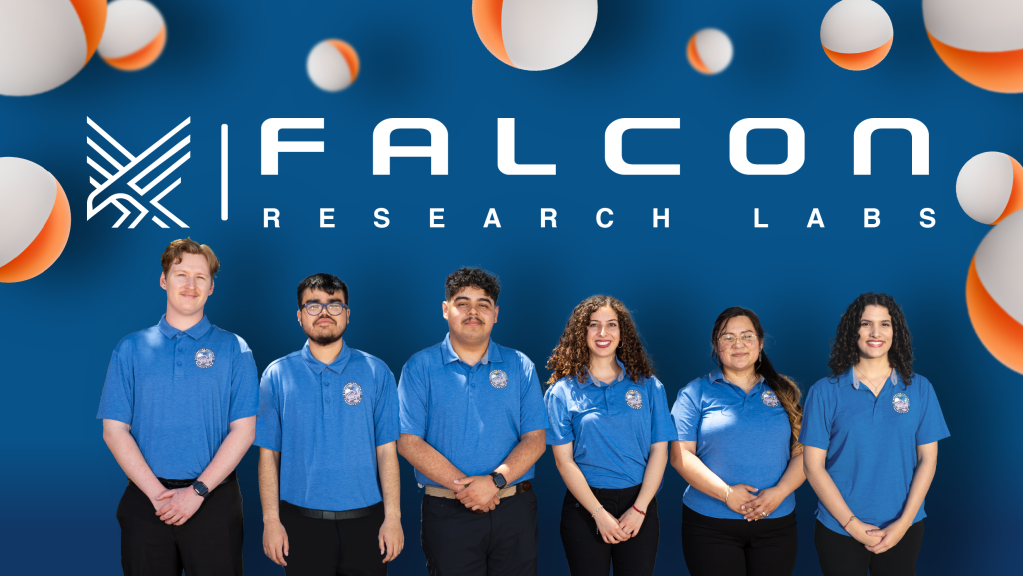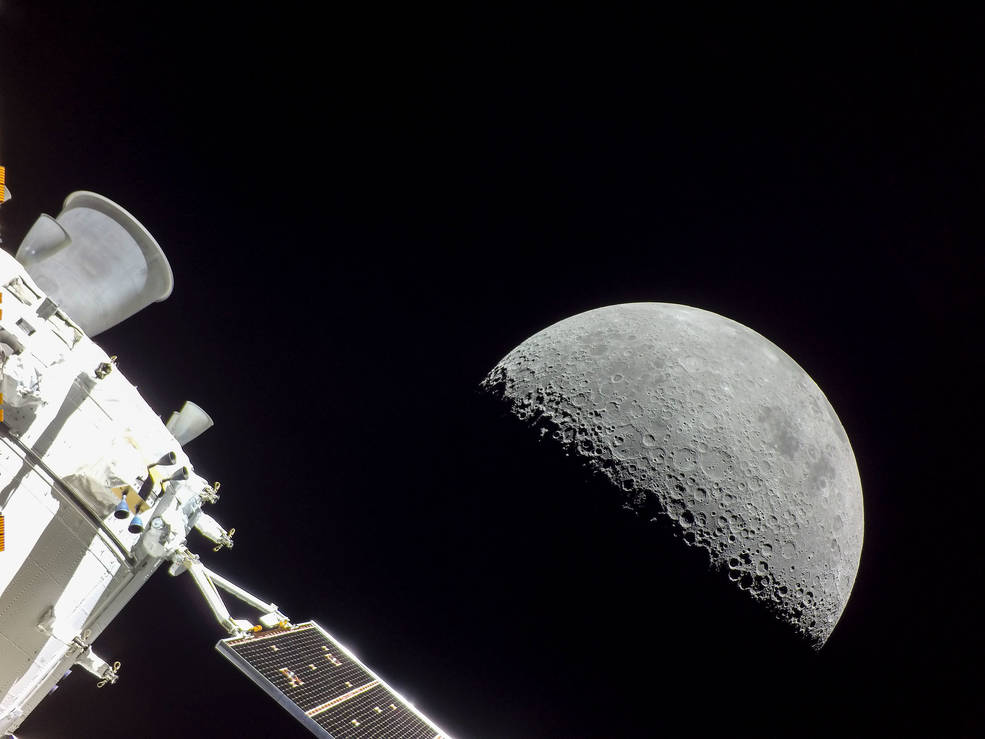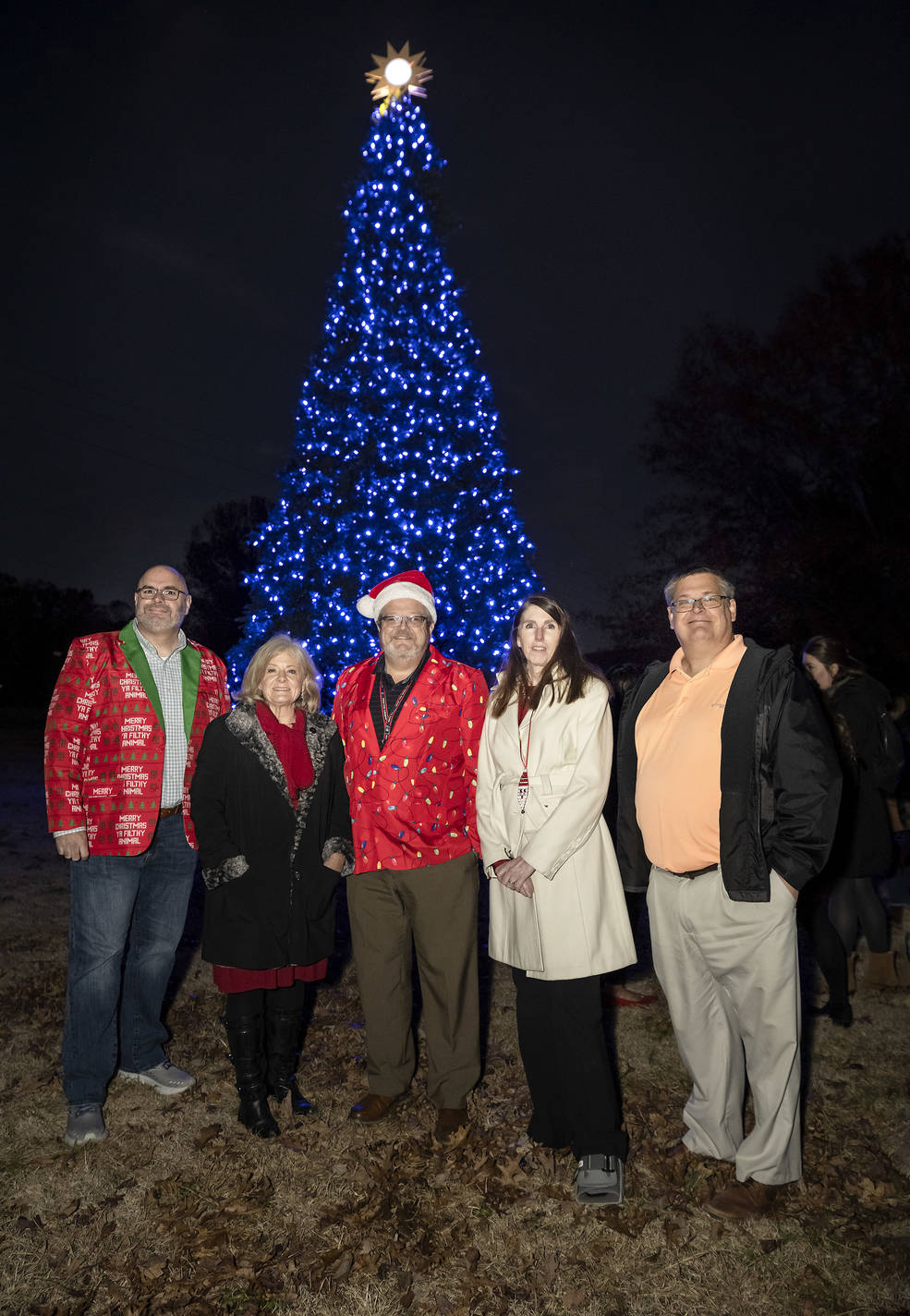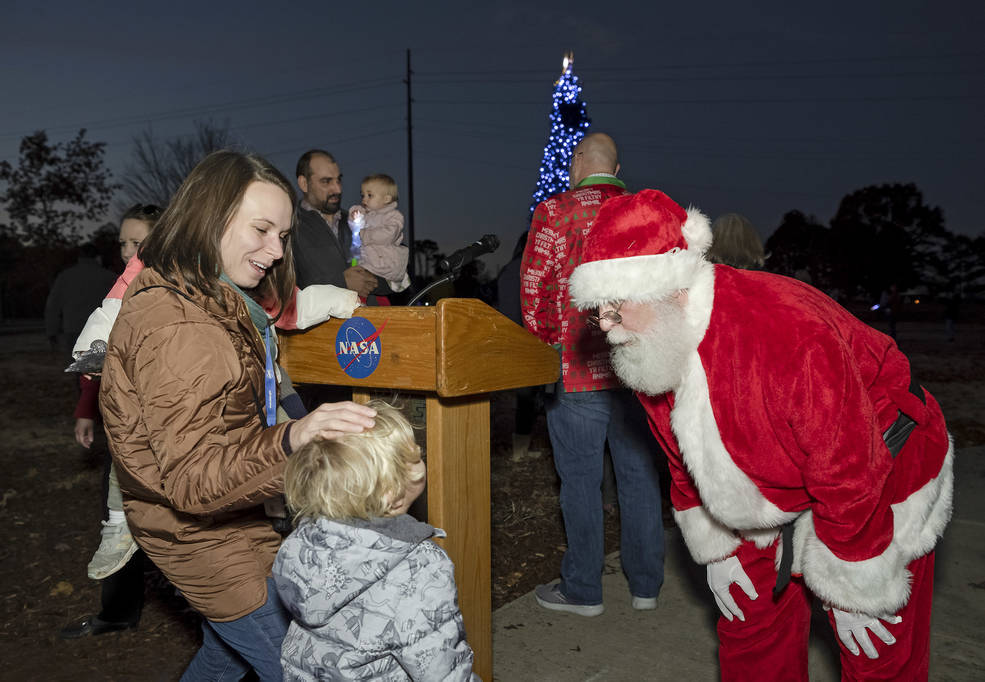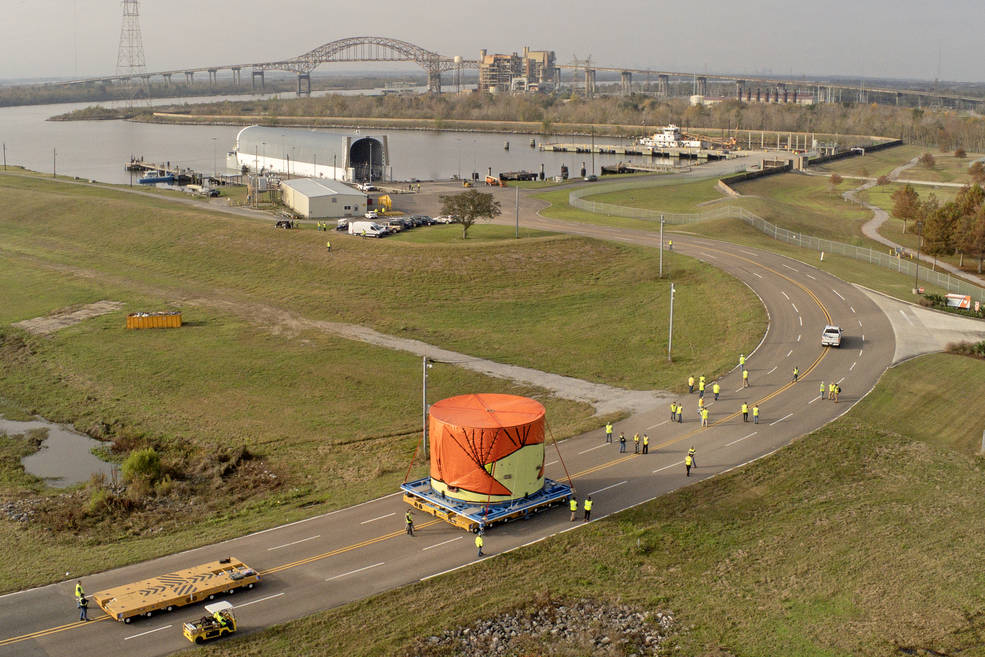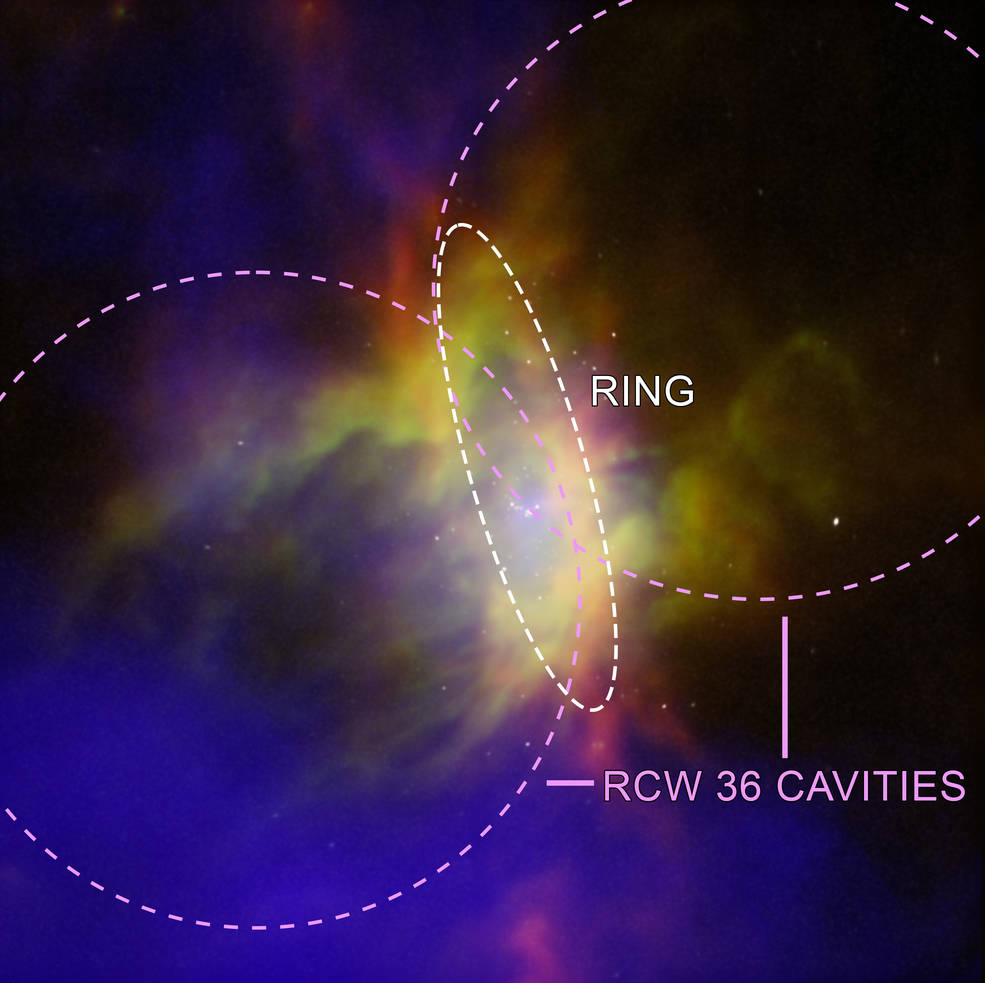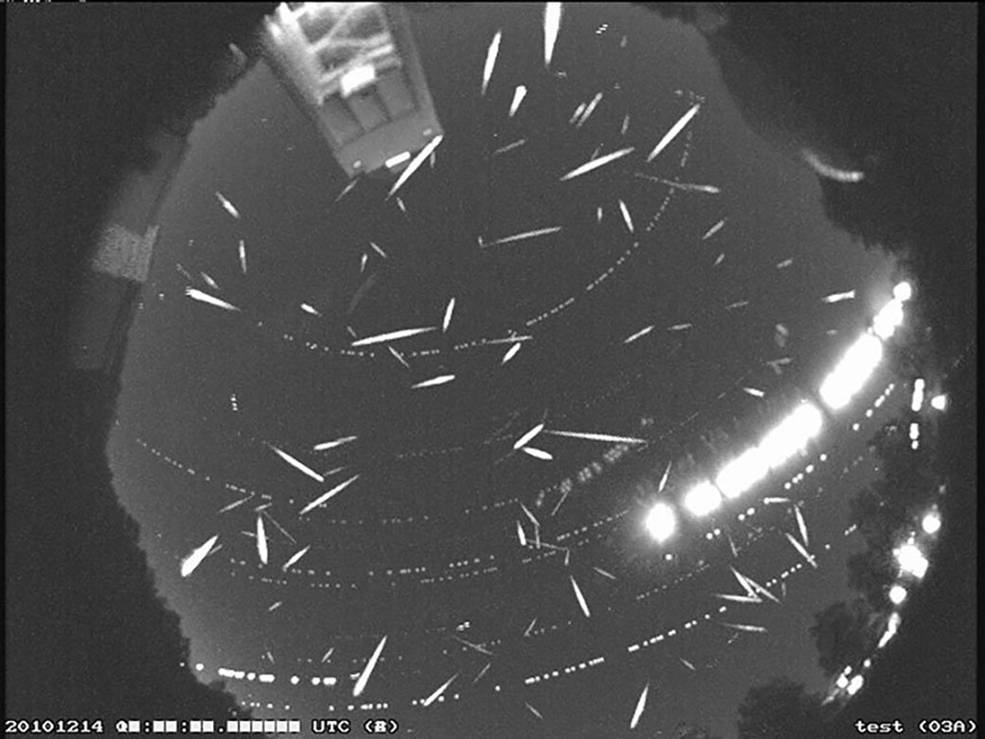The Marshall Star for December 7, 2022.
In This Week’s Star
- Orion Conducts Return Powered Flyby, set for Dec. 11 Splashdown
- Marshall Honors Outstanding Achievements at Virtual Awards Ceremony
- Marshall Leaders, Families Celebrate Annual Tree Lighting
- Team Members Reunite at Marshall Holiday Reception
- NASA Advances Artemis Moon Rocket Production for Future Missions
- 50 States: Propulsion
- NASA Awards Environmental Compliance, Restoration Services Contract
- Chandra: Astronomers See Stellar Self-Control in Action
- The 2022 Geminids Meteor Shower Is Approaching
Orion Conducts Return Powered Flyby, set for Dec. 11 Splashdown
NASA’s Orion spacecraft is on course for its return to Earth on Dec. 11. The spacecraft made its second and final close approach to the Moon at 10:43 a.m. CST Dec. 5, just before its return powered flyby burn, passing 80.6 miles above the lunar surface.
The burn, which used the spacecraft’s main engine on the European-built service module, lasted 3 minutes, 27 seconds, and changed the velocity of the spacecraft by about 655 mph (961 feet per second). It was the final major engine maneuver of the flight test.
“Orion is heading home! Today the team achieved another momentous accomplishment, flying Orion just 80 miles from the surface of the Moon. The lunar flyby enabled the spacecraft to harness the Moon’s gravity and slingshot it back toward Earth for splashdown,” said Administrator Bill Nelson. “When Orion re-enters Earth’s atmosphere in just a few days, it will come back hotter and faster than ever before – the ultimate test before we put astronauts on board. Next up, re-entry!”
Several hours before the lunar flyby, the spacecraft performed a trajectory correction burn at 4:43 a.m. CST using the reaction control system thrusters on the service module. The burn lasted 20.1 seconds and changed the velocity of the spacecraft by 1.39 mph (2.04 feet per second).
The mission management team convened and polled “go” to deploy recovery assets off the coast of California ahead of Orion’s splashdown on Dec. 11. As soon as Orion splashes down, a team of divers, engineers, and technicians will depart the ship on small boats and arrive at the capsule. Once there, they will secure it and prepare to tow it into the back of the ship, known as the well deck. The divers will attach a cable to pull the spacecraft into the ship, called the winch line, and up to four additional tending lines to attach points on the spacecraft. The winch will pull Orion into a specially designed cradle inside the ship’s well deck and the other lines will control the motion of the spacecraft. Once Orion is positioned above the cradle assembly, the well deck will be drained and Orion will be secured on the cradle.
“Last week, we completed our final rehearsal with the USS Portland, which will be our recovery ship for Artemis I,” said Melissa Jones, landing and recovery director, NASA’s Kennedy Space Center. “We had a great three days working with them to refine our procedures and integrate our teams so we can meet the objectives of recovering the Orion spacecraft.”
The Orion spacecraft is set to return to Earth and complete the Artemis I mission by landing in the Pacific Ocean at approximately 11:40 CST that morning following its flyby of the Moon. The U.S. Space & Rocket Center and Rocket City Trash Pandas will host an Orion splashdown party Dec. 11 from 10:30 a.m. to 1 p.m. at Toyota Field in Madison to celebrate the mission. Marshall Director Jody Singer and Space Launch System (SLS) Program Manager John Honeycutt will be among the special guests who will address the crowd prior to splashdown.
For Artemis updates, visit here.
Follow along and track Orion via the Artemis Real-Time Orbit Website, or AROW, and watch live footage from the spacecraft. You can also find the latest images from Orion on the Johnson Space Center Flickr account.
Marshall Honors Outstanding Achievements at Virtual Awards Ceremony
NASA’s Marshall Space Flight Center held its Center Honor Awards virtual ceremony Dec. 7. The awards are presented in recognition of outstanding accomplishments and achievements each year. This year, there were 142 awards presented to individuals and 61 presented to teams for their vital contributions to the Marshall mission. You can watch the ceremony on Marshall’s YouTube channel and on Inside Marshall. This year’s theme is “Marshall: Launching NASA into the future, to the Moon and Beyond.” Reid Wiseman, chief of the Astronaut Office, delivered the keynote address. See the complete roster of awards and recipients here. (NASA)
Marshall Leaders, Families Celebrate Annual Tree Lighting
NASA’s Marshall Space Flight Center leadership, team members, and their families gathered Dec. 1 for the annual lighting of the holiday tree on the lawn of Building 4260. Marshall leaders, from left: Deputy Director Joseph Pelfrey, Director Jody Singer, Center Operations Director Robert Champion, Associate Director Rae Ann Meyer, and Associate Director, Technical Larry Leopard. The 32-foot-tall artificial tree is trimmed in blue lights and topped with a 3D NASA logo backed by a 10-pointed star, each point representing a NASA center. The tree-topper was designed and constructed by Aaron Stanfield, a Marshall exhibits technician and model-maker. The tree will remain on display until after the new year and can be viewed from Rideout Road. (Credits: NASA/Charles Beason)
Santa Claus visits with Marshall project manager Michelle Tillotson Rudd and her son, Lyal Rudd, during the annual tree lighting event Dec. 1 on the lawn of Building 4260. Marshall Director Jody Singer welcomed the crowd and introduced the children from the Marshall Child Development Center, who cheerfully sang a few carols. “This is a season to celebrate our loved ones – friends and family – and of course, our Marshall family,” Singer said. “We are so proud of the collaborative efforts of the entire Marshall team. After years of hard work, I know we were all proud to see Artemis I launch, and it’s because of so many of you here today.” Following the tree lighting, attendees enjoyed hot chocolate and cookies in the building lobby. (Credits: NASA/Charles Beason)
Team Members Reunite at Marshall Holiday Reception
For the first time in three years, team members at NASA’s Marshall Space Flight Center gathered Dec. 6 in Building 4316 to celebrate the season with a holiday reception. Festive twinkle lights and colorful Christmas trees lit up the room, which hummed with conversation as team members caught up and exchanged hugs and handshakes. For some, it was the first time coming on site since March 2020. Marshall Director Jody Singer cheerfully greeted team members at the door with NASA notebooks and later welcomed the crowd from the front of the room. “Whether you have just joined the team or have been working with us for many years – I hope you feel extreme pride in what we’ve achieved together,” she said. “I know we are still waiting on the Orion capsule to splash down, but I wanted to take this opportunity to say how proud I am of our center for playing such a critical part of the Artemis I mission.” Team members enjoyed refreshments catered by Southern Foods while waiting to see if they would win some of the $1,200 in cash card giveaways from the Marshall Exchange team. Below, winners of the cash cards included team members, from left, Randy Cornelius, Karen Berry, and Zenia Garcia. (NASA/Alex Russell)
NASA Advances Artemis Moon Rocket Production for Future Missions
NASA is moving forward with Space Launch System (SLS) production and assembly activities for future Artemis missions.
The agency is optimizing manufacturing capabilities by enabling SLS core stage lead contractor Boeing to use facilities at NASA’s Kennedy Space Center to perform some core stage assembly and outfitting activities beginning with the Artemis III rocket. In tandem, teams will continue all core stage manufacturing activities at NASA’s Michoud Assembly Facility.
As the SLS program transitions from rocket development efforts to operations, NASA and Boeing evaluated how to improve upon the time required to produce each core stage and best use space at Michoud.
“We’re making progress developing, manufacturing, and assembling elements for future Artemis missions,” said Jim Free, associate administrator for the Exploration Systems Development Mission Directorate. “Our collective workforce across NASA centers and industry partners plays a key role in accomplishing NASA’s long-term plans for exploring the Moon.”
Beginning with production for Artemis III, NASA and Boeing will use Michoud, where the SLS core stages are currently manufactured, to produce and outfit the core stage elements, and available space at Kennedy for final assembly and integration. This opportunity provides for multiple mission elements to be manufactured and outfitted at the same time and for the workforce at Michoud to begin building the rocket’s exploration upper stage, which will enable SLS to send even heavier and larger cargo to the Moon on the same missions with astronauts beginning with Artemis IV.
All five major core stage structures will be manufactured at Michoud using current robotic welding tools and fixtures and complete all thermal protection system spray applications at Michoud. There, the forward skirt, the intertank, liquid oxygen tank, and the liquid hydrogen will continue to be outfitted and joined to form the upper part of the core stage. Upon completion, these structures, which comprise the top four-fifths of the 212-foot-tall stage, will be shipped to Kennedy’s Vehicle Assembly Building (VAB) where they will be joined and vertically integrated in High Bay 2.
Once the engine section structure is manufactured, it will be transported to Kennedy’s Space Station Processing Facility for outfitting in the facility. When the engine section is completely outfitted, it and the stage’s four RS-25 engines will be moved to the VAB’s High Bay 2 for integration with the rest of the core stage, where technicians can more easily move it for stacking and assembly operations.
Four of five major core stage parts for Artemis II have been joined, and teams are outfitting the last part, the engine section, and will soon connect it and the RS-25 engines to complete the stage at Michoud. The Artemis II stage is scheduled to be completed and delivered to Kennedy in 2023. The engine section for the Artemis III SLS core stage is expected to arrive at Kennedy in mid-December.
With Artemis, NASA will land the first woman and the first person of color on the lunar surface and establish long-term exploration at the Moon in preparation for human missions to Mars. SLS and NASA’s Orion spacecraft, along with the commercial human landing system and the Gateway in orbit around the Moon, are NASA’s backbone for deep space exploration.
The SLS Program is managed by NASA’s Marshall Space Flight Center. Marshall also manages Michoud.
50 States: Propulsion
Check out some of the companies across America that helped NASA propel Artemis I to the Moon. (NASA)
NASA Awards Environmental Compliance, Restoration Services Contract
NASA has awarded the Architect-Engineer Services Contract for Environmental Compliance and Restoration Services to Jacobs Engineering Group Inc. of Dallas, to provide environmental compliance, monitoring, and remediation services at the Santa Susana Field Laboratory (SSFL) located in Ventura County, California.
The indefinite-delivery/indefinite-quantity contract with firm fixed price task orders has a base period of one year, which began Dec. 1, followed by four one-year option periods that may be exercised at NASA’s discretion. The potential value of the contract, including options, is approximately $92.5 million.
NASA’s top priority at SSFL is to achieve an environmental cleanup that is protective of public health and the environment. This contract reflects the agency’s ongoing commitment to approach the cleanup using the best science and technology available to minimize impacts to the site’s important natural and cultural resources, while protecting the surrounding community.
Chandra: Astronomers See Stellar Self-Control in Action
Many factors can limit the size of a group, including external ones that members have no control over. Astronomers have found that groups of stars in certain environments, however, can regulate themselves.
A new study has revealed stars in a cluster having “self-control,” meaning that they allow only a limited number of stars to grow before the biggest and brightest members expel most of the gas from the system. This process should drastically slow down the birth of new stars, which would better align with astronomers’ predictions for how quickly stars form in clusters.
This study combines data from several telescopes including NASA’s Chandra X-ray Observatory, NASA’s now-retired Stratospheric Observatory for Infrared Astronomy (SOFIA), the APEX (the Atacama Pathfinder EXperiment) telescope, and ESA’s (European Space Agency’s) retired Herschel telescope.
The target of the observations was RCW 36, a large cloud of gas called an HII (pronounced “H-two”) region mainly composed of hydrogen atoms that have been ionized – that is, stripped of their electrons. This star-forming complex is located in the Milky Way about 2,900 light-years from Earth. Infrared data from Herschel is shown in red, orange, and green, and X-ray data is blue, with point sources in white. North is 32 degrees left of vertical.
RCW 36 contains a cluster of young stars and two cavities – or voids – carved out of the ionized hydrogen gas, extending in opposite directions. There is also a ring of gas that wraps around the cluster in between the cavities, forming a waist around the hourglass-shaped cavities. These features are labeled in the image.
Hot gas with a temperature of about two million kelvins (3.6 million degrees Fahrenheit), radiating in X-rays detected by Chandra, is concentrated near the center of RCW 36, close to the two hottest and most massive stars in the cluster. These stars are a major source of the hot gas. A large amount of the rest of the hot gas is outside the cavities, after having leaked through the borders of the cavities. The SOFIA and APEX data shows that the ring contains cool, dense gas (with typical temperatures of 15 to 25 kelvins, or about -430 to -410 degrees Fahrenheit) and is expanding at 2,000 to 4,000 miles per hour.
The SOFIA data show that on the perimeter of both cavities are shells of cool gas expanding at about 10,000 miles per hour, likely being driven outward by pressure from the hot gas observed with Chandra. The hot gas, plus radiation from stars in the cluster, has also cleared even larger cavities around RCW 36, forming a Russian doll structure. These features are labeled in a Herschel image covering a larger area, which also shows the Chandra field-of-view and the other structures described here. The intensity levels in this image have been adjusted to show the larger cavities as clearly as possible, causing much of the inner regions near the RCW 36 cavities to be saturated. North is vertical in this image.
The researchers also see evidence from the SOFIA data for some cool gas around the ring being ejected from RCW 36 at even higher speeds of about 30,000 miles per hour, with the equivalent of 170 Earth masses per year being pushed out.
The expansion speeds of the different structures described here, and the mass ejection rate, show that most of the cool gas within about three light-years of the center of the HII region can be ejected in 1 million to 2 million years. This will clear out the raw material needed to form stars, suppressing their continued birth in the region. Astronomers call this process where stars can regulate themselves “stellar feedback.” Results such as this help us understand the role stellar feedback plays in the star formation process.
A paper describing these results appeared in the Aug. 20 issue of The Astrophysical Journal and is available online. The authors are Lars Bonne (NASA Ames Research Center), Nicola Schneider (University of Cologne, Germany), Pablo Garcia (Chinese Academy of Sciences), Akanksha Bij (Queen’s University, Canada), Patrick Broos (Penn State), Laura Fissel (Queen’s University) , Rolf Guesten (Max Planck Institute for Radio Astronomy, Germany), James Jackson (NASA Ames), Robert Simon (University of Cologne), Leisa Townsley (Penn State), Annie Zavagno (Aix Marseille University, France), Rebeca Aladro (Max Planck Institute for Radio Astronomy), Christof Buchbender (University of Cologne), Cristian Guevara (University of Cologne), Ronan Higgins (University of Cologne), Arshia Maria Jacob (Max Planck Institute for Radio Astronomy), Slawa Kabanovic (University of Cologne), Ramsey Karim (University of Maryland), Archana Soam (NASA Ames), Jurgen Stutzki (University of Cologne), Maitraiyee Tiwari (University of Maryland), Freidrich Wyrowski (Max Planck Institute for Radio Astronomy), and Alexander Tielens (University of Maryland).
NASA’s Marshall Space Flight Center manages the Chandra program. The Smithsonian Astrophysical Observatory’s Chandra X-ray Center controls science operations from Cambridge, Massachusetts, and flight operations from Burlington, Massachusetts.
SOFIA was a Boeing 747SP aircraft modified to carry a reflecting telescope. The observatory was a joint project of NASA and the German Space Agency at DLR.
The 2022 Geminids Meteor Shower Is Approaching
By Lane Figueroa
The cosmos’ annual gift to sky watchers, the Geminids Meteor shower, will peak on Dec. 13-14 this year.
During peak activity and perfect weather conditions, which are rare, the Geminids produce approximately 100-150 meteors per hour for viewing. However, this year a wanning gibbous moon will make it harder to view most of the shower, resulting in only 30-40 visible meteors per hour at the peak in the Northern Hemisphere, depending on sky conditions. But the Geminids are so bright that this should still be a good show.
Bill Cooke, lead of NASA’s Meteoroid Environments Office at Marshall Space Flight Center, suggests sitting in the shade of a house or tree while also maintaining a view of the open sky to alleviate moonlight interference.
The meteor shower is coined the Geminids because the meteors appear to radiate from the constellation Gemini. According to Cooke, meteors close to the radiant have very short trails and are easily missed, so observers should avoid looking at that constellation. However, tracing a meteor backwards to the constellation Gemini can determine if you caught a Geminid (other weaker showers occur at the same time).
Gemini does not appear very high above the horizon in the Southern Hemisphere, resulting in viewers only seeing approximately 25% of the rates seen in the Northern Hemisphere, which is between 7-10 meteors per hour. Sky watchers from the Southern Hemisphere are encouraged to find areas with minimal light pollution and look to the northern sky to improve their viewing opportunities.
The Geminids start around 9 or 10 p.m. CST on Dec. 13, making it a great viewing opportunity for any viewers who cannot be awake during later hours of the night. The shower will peak at 6 a.m. CST on Dec. 14, but the best rates will be seen earlier around 2 a.m. local time. You can still view Geminids just before or after this date, but the last opportunity is on Dec. 17 – when a dedicated observer could possibly spot one or two on that night.
For prime viewing, find an area away from city and streetlights, bundle up for winter weather conditions, bring a blanket or sleeping bag for extra comfort, lie flat on your back with your feet facing south, and look up. Practice patience because it will take approximately 30 minutes for your eyes to fully adjust and see the meteors. Refrain from looking at your cell phone or other bright objects to keep your eyes adjusted.
The show will last for most of the night, so you have multiple opportunities to spot the brilliant streaks of light across our sky.
So where does this magnificent shower come from? Meteors are fragments and particles that burn up as they enter Earth’s atmosphere at high speed, and they usually originate from comets.
The Geminid shower originates from the debris of 3200 Phaethon an asteroid first discovered on Oct. 11, 1983, using the Infrared Astronomical Satellite. Phaethon orbits the Sun every 1.4 years, and every year Earth passes through its trail of debris, resulting in the Geminids Shower.
Phaethon is the first asteroid to be associated with a meteor shower, but astronomers debate its exact classification and origins. Phaethon lacks an icy shell (the staple characteristic of a comet), but some consider it a “dead comet” – suggesting it once had an icy shell that melted away. Other astronomers call it a “rock comet” because Phaethon passes very close to the Sun during its orbit, which theoretically results in heating and cracking that creates debris and dust. The bottom line is Phaethon’s exact origins are still a mystery, but we do know it’s the Geminids parent body.
Geminids travel 78,000 miles per hour, over 40 times faster than a speeding bullet, but it is highly unlikely that meteors will reach the ground – most Geminids burn up at altitudes between 45 to 55 miles.
In addition to sky watching opportunities, meteor videos recorded by the NASA All Sky Fireball Network are available each morning to identify Geminids in these videos – just look for events labeled “GEM.”
And, if you want to know what else is in the sky for December, check out the video from Jet Propulsion Laboratory’s monthly “What’s Up” video series.
Figueroa, a Media Fusion employee, supports Marshall’s Office of Strategic Analysis & Communications.






















